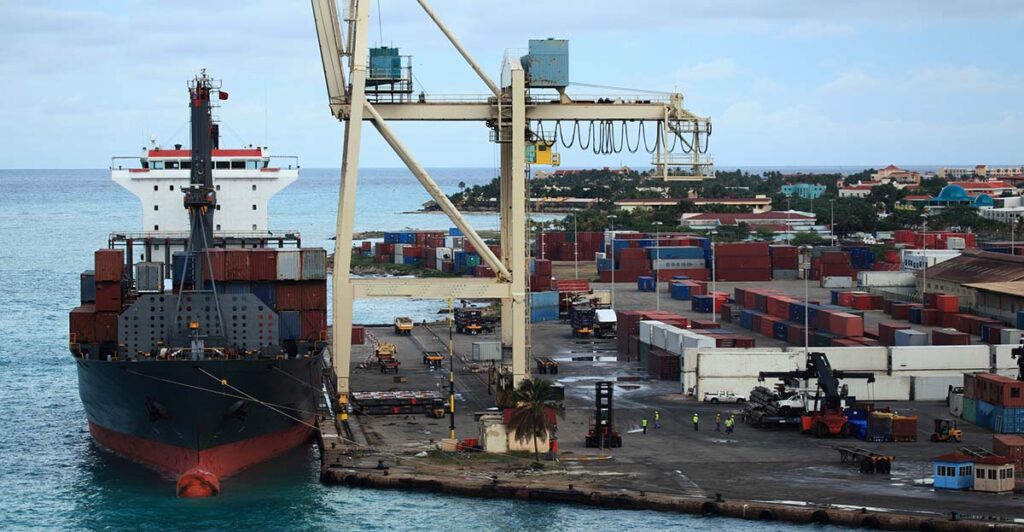In addressing the demands and challenges of 2024 and beyond, Dutch Caribbean ports have established alliances within and outside of the Caribbean region.
By Jan Sierhuis *
Dutch Caribbean territories have teamed up with ports (including Amsterdam and Rotterdam) and Dutch research institutions (including TU Delft and TNO) to make the technology change with pilot projects utilising public and private funding. Aruba, Curaçao and Sint Maarten are key players in the regional cruise business. And Sint Maarten is growing as a sub-regional container port in the Eastern Caribbean.
All these ports are government-owned, limited liability companies (N.V.’s) and are investing in upgrading their facilities for the new cruise ships and to supply them with green fuel and shore power.
Shore power is still in the planning phase, as local power capacity is limited and cruise ships would use much of what these small territories can produce. However, all countries are planning for green energy project with local and international energy partners. Some adopt an innovative approach to the limitations by taking a regional, or even global export perspective on the energy market.
- Aruba Ports Authority
 Prior to the pandemic, the Aruba Ports Authority N.V. (APA) made crucial investments in the maritime aspects of their operation, encompassing key undertakings, including dredging and installing Yokohama fenders and 150-ton bollards. Attention then shifted to the landside. Investments resumed in 2023 and included the resurfacing of the quays.
Prior to the pandemic, the Aruba Ports Authority N.V. (APA) made crucial investments in the maritime aspects of their operation, encompassing key undertakings, including dredging and installing Yokohama fenders and 150-ton bollards. Attention then shifted to the landside. Investments resumed in 2023 and included the resurfacing of the quays.
Total APA investments in 2023 were financed from cashflow and amounted to over USD1.7 million.
The APA initiated the Cruise Experience Development Plan to prepare the cruise port for the next 15+ years. This plan entails an evaluation of all aspects of port operations including passenger flows, transport dispatches and traffic management, the objective being to elevate the port arrival experience.
The mid-term challenge to decarbonise port operations is the provision of shore power from green energy sources. This has become increasingly necessary to assist cruise lines in meeting their decarbonisation targets and align the port with the global endeavour towards a carbon-neutral maritime industry.
“APA is actively engaged in discussions with key energy partners to evaluate the feasibility of this vital undertaking from both technical and financial standpoints. The provision of shore power involves substantial investments and intricacies in supply and demand dynamics, which pose a challenge for small island states like Aruba,” said CEO Marc Figaroa.
Included in APA’s plans for 2024 APA is the commissioning of an advanced port management system. This will play a significant role in facilitating electronic data exchange and to comply with the IMO’s Maritime Single Window deadline of January 2024.
Total APA investments in 2024, which will be financed privately, were estimated at USD5 million.
- Curaçao Ports Authority
 The Curaçao Ports Authority (CPA) continues to upgrade and prepare its cruise berths for the new generation of ships. The CPA teamed up with local energy suppliers to address the green energy transition of the port. Projects include green bunker fuels and alternative energy for exports, including visiting ships. Most projects are in the planning phase, but some are in preparation.
The Curaçao Ports Authority (CPA) continues to upgrade and prepare its cruise berths for the new generation of ships. The CPA teamed up with local energy suppliers to address the green energy transition of the port. Projects include green bunker fuels and alternative energy for exports, including visiting ships. Most projects are in the planning phase, but some are in preparation.
“For next year CPA continues to invest in port infrastructure, the upgrade of the cruise terminal and further development of the St. Anna Bay area, according to the masterplan, a downtown development plan that started several years ago,” said Raul Manotas, CPA’s Chief Commercial Officer.
The CPA is also assisting the government with the implementation of a Maritime Single Window and is further investing in infrastructure and training programmes related to cyber security. CPA is looking into the feasibility of shore power methods and AI trends. Total investments for 2024 are estimated at USD 25 million from both public and private funding.
The CPA is part of Curaçao’s Green Hydrogen Value Chain project which was recently launched by the Government. Described as a transformative initiative, it is aimed at large-scale offshore production and export of green hydrogen.
- Port of Sint Maarten Group

Port of Sint Maarten Group’s (PSG) port investment focus is on operational excellence and transshipment. This will be done by further optimising the Port Community System and through the implementation of Cargo GLS wharf planning.
Sint Maarten is one of the few ports in the Caribbean with the Single Maritime Window online. PSG intends to extend the current reefer park to address growing shipping demands and to bolster its position as a regional transshipment hub. Increased automation to simplify and enhance processes to increase operational efficiencies is also a focal point for the PSG.
On the cruise side, PSG recently commenced facility upgrades towards an enhanced port experience. These investments continue through to 2024. Reinforcement of the port infrastructure and preparations for future larger vessels are also slated for 2024. In addition to the economic benefits, these enhancements will improve the safety and security of operations and increase the storm resilience of the facility.
Destination investments are planned for the next two years to increase the ‘island experience’ of the passengers. This includes an assessment with a view to improving the mix of offerings in the cruise terminal. PSG plans to invest some USD50 million over the next 5 years to upgrade its facilities and port community system. Investment financing will come from both public and private sources.
With respect to the energy transition, PSG is committed to reducing environmental impact and has installed an environmental impact department.
“We are actively exploring options to transition to cleaner fuels and shore power is being investigated. Due to the small size of the destination and the required capacity and investments, shore power will be a challenge. But, PSG remains committed to identifying feasible solutions and understands its role in assisting clients to meet their operational and environmental goals, while staying in our ports,” said Alexander Gumbs CEO of the Port St. Maarten Group. []
- First published: December 1, 2023
#DutchCaribbean #Caribbeanports #ClimateChange #GreenEnergy #ShorePower

* Jan Sierhuis is a Caribbean maritime specialist and Portside Caribbean columnist.





